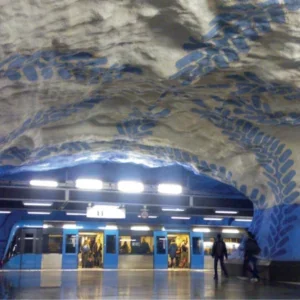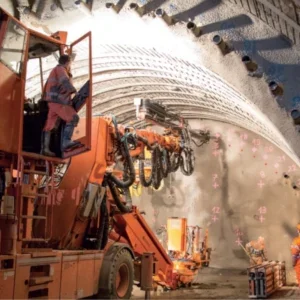The speakers presented results from their detail analysis on EPBM tunnelling and how changes to the conditioning of the excavated soil cope with the varying challenges presented by the highly permeable soil layers on the Canada Line Transit Tunnels, in Vancouver, BC.
The Canada Line is a 19km long automated light rapid transit system with 16 stations in Vancouver, BC, Canada. The Concession was awarded to InTransitBC to design, build, partially finance, operate, and maintain the system for 35 years. The project must be complete by November 2009 to be ready for the 2010 Winter Olympics to be held in Vancouver and Whistler, BC. The bored tunnel section consists of 2.45km of twin-bored tunnel and 3 stations (figure 1).
The tunnels were driven using a Lovat 6m diameter EPBM and lined with 250mm thick, 5.3m i.d. precast concrete segments. Seven hundred and fifty meters of each tunnel were driven through glacial and interglacial deposits of sand, silt, and clay with granitic boulders.
The station work is limited to the excavations and temporary support necessary to facilitate the bored tunnel works. A joint venture between SNC-Lavalin Constructors Pacific and Seli has recently completed the design and construction of this section.
Approximately in the middle of the False Creek, the geology changes from sandstone into the overlying till (a glacial deposit of silt and sands). The transition is foreseen through a discontinuity having a sub–vertical immersion.
The geomechanical conditions considered in the analyses correspond to a situation frequently faced while boring the stretch of twin tunnels from False Creek to Granville Street, which was characterised by the presence of significantly continuous layers of high permeability loose till.
Although it is likely that more than a single layer exists, possibly with additional minor inclusions and lenses of limited extent, to keep the model as simple as possible a unique layer was considered. The thickness of the soft layer was fixed equal to 1.5m, that is D/4 (where D is the tunnel diameter, equal to 6m), while its position within the face was varied: i.e., four cases were considered, corresponding to a relative elevation z of the base of the layer, with respect to the tunnel axis, of -3, -1.5, 0 and 1.5m. The set of performed analyses include also two situations of entirely homogeneous soil, i.e., without a soft layer and with a soil mass formed only of soft material, respectively.
The behaviour of the water-saturated porous medium during excavation advance was represented by a two-phase approach. Only the drained elastic moduli and the drained strength parameters are therefore required, while the undrained behaviour is governed by the water bulk modulus (Kw = 2GPa), porosity and the skeleton bulk modulus. The geomechanical properties of soils from site report and additional investigations are shown in Table 1 (p39).
Into the till
In Drive 1 the transition from sandstone to till went smoothly without any geological anomalies becoming apparent. Once the machine was wholly in the till, face inspections under atmospheric pressure showed it to be comprised of strong impermeable till. Regular cutter head inspections and tool changes could be made in normal (atmospheric) conditions. Surface and building settlements were limited to 1 or 2mm with minimum cover of 12m to the crown of the tunnel and water table approximately 8m below surface. A face support pressure of approximately 1bar was maintained throughout. However, after 120m the muck was noted to contain higher proportions of wet sand and silt.
From this point on the total thrust of the TBM and the cutter head torque began to steadily increase with a steady decrease in penetration rate. However, extracted muck weights and settlement stayed at, or slightly above, normal so the TBM was advanced to find suitable ground for a face intervention, but the muck exhibited higher percentages of cohesionless sand showing the waterlogged permeably material was not confined to a pocket, but was a layer with recharging water.
It became clear that the cutting tools were at the end of their useful life. Face interventions were still not possible and sensor observations made during lowering the pressure in the excavation chamber showed that even with compressed air inside the chamber the water level would increase.
The increasing coarseness of the material combined with the high water pressure meant the foaming agent was not effective. In these instances, the muck was permeable and would allow water to flow through the screw conveyor.
However, this conditioning was less than ideal and the material would flow through the screw conveyor if not mechanically managed by partial closure of the guillotine door. With the cutting tools in such poor condition, there was significant concern that the machine could become immobilized as it entered the sandstone under a significant building.
The decision on how to continue the drive under the highest risk section with a machine of reduced capacity due to excessive wear and probable damage was based on a number of factors. The settlement readings in all buildings along this section had remained very low (less than 4mm) and surface settlements had remained less than 3mm in all but one section.
Experience had shown that adequate ground control could be achieved even with worn cutting tools and very poor ground conditions unsuited to normal EPBM operations.
Considering all the facts, a calculated risk was taken to continue the drive. The TBM under-passed the building (34 advances) in less than 5 days with the penetration rates reducing from 50 to 30mm/min. The maximum settlement experienced at any footing was 6mm with 3 or 4mm being normal for other footings directly over the alignment.
For the entire section of till, the cutter head was dressed with disc cutters that were required for two reasons; to bore within the rock at each end of the soil section and to bore through the boulders that are confined in the stiff/hard till matrix. Through the wet sands and silts, the scraper teeth at the cutter head openings will have done most of the “cutting”.
Drive two
Before Drive 2 and following a specific risk evaluation report an additional package of improvements, refinements, and modifications was introduced as risk mitigation measures to enhance the operational and functional efficiency of the TBM in the reassessed geology.
Due to the unfavourable geological conditions and the dense urban environment in this section several mitigation measures have been taken, such as:
• Tunnel separation increased by 1 diameter (from 12m to 18m) under significant buildings to minimize their interaction
• Use of long-life and high wear resistance cutting tools with a mixed-face configuration (ripper teeth and cutters)
• Automatic grout line cleaning at the end of each stroke by a shot of hydraulic oil
• Polymer injection: the addition of an automatic integrated Polymer System pump to the original conditioning foaming system
• Additional monitoring instrumentation and 24-hour monitoring (surface, buildings, and extensometers) during the most critical sections
• Locating maintenance areas based on the Drive 1 reassessed geological mapping and records, where safe and “open face” cutting head maintenance might be possible
• Hyperbaric crew: Specialised crews for hyperbaric intervention available on site (until the tunnel is fully into the sandstone formation)
• Operations and boring parameter control: phases and values checked daily based on shift reports and PLC automatic data logger. Daily toolbox meeting for coordination and planning
• More frequent calibration of weight scales as the belt scales are adversely affected by very wet soils and the vertical and horizontal curves
The mitigation measures and the scheduled maintenance areas were instrumental in the efficacy of the excavation through the entire till section, and the reduction of risks from Drive 1 greatly enhanced the performance of the TBM, particularly the ability to keep the proper face support pressure and assure the right conditioning reducing the soil permeability. These two aspects were thoroughly studied before approaching the sand layer during Drive 2. In Drive 2 the ground control confirmed by the surface, building, and soil monitoring instruments were very similar to Drive 1.
The machine advanced at an average of 12 rings per day (17m), at 2.2 bar face support pressure at the top of the cutting chamber. The penetration rates, total thrust, torque, grout injection pressures and volumes all remained within expected limits with the torque and thrust increasing and penetration rate dropping as the machine entered the sandstone. The ability to maintain the design face support pressure (not having to drop the pressure to allow forward advance), thus balancing the hydrostatic pressure (therefore not mobilizing any ground water through the sand) allowed the soil to be conditioned only by the injection of foam. Conditioning of granular material, to make the muck into the required impermeable consistency, was therefore achieved at chamber pressures of 2.7 bar (at inlet to screw conveyor).
The soil conditioning system had been checked and continuously updated along a 200m trial section of Drive 2.
Several tests had been performed on spoil material removed from the screw conveyor screening:
• Slump
• Density
• Permeability
• Moisture content
All the parameters related to every TBM stroke had been filed and analysed. On the trial stretch, face foam flow, surfactant percentage (TA%) and water flow in the chamber have been modified to verify the TBM behaviour under different conditions (high or low excavation pressure, till matrix with or without sandy inclusions, etc).
Besides laboratory tests on till mixed with sand had been made. Addition of polymer agents had been studied too. Eventually the most effective conditioning parameters granted reaching a permeability of the excavation spoil ranging from 10-7 to 10-8m/s.
A thorough preliminary analysis of face stability was undertaken reviewing spatial stress redistribution in the vicinity of the advancing face.
A sensitivity was aimed at evaluating the influence of the following factors; the position of the high permeability layer inside the face, the shape of the total pressure distribution upon the face and the amount of pore pressure reduction inside the chamber with respect to the undisturbed ground.
A further analysis was devoted to the study of a simplifying modelling approach in which the flow domain is limited to the high permeability layer, while the medium till portion of the model is assumed to display a fully undrained response during excavation advance.
A set of figures showing some results of the preliminary analyses is thereafter included: most figures refer to the situation where the high permeability layer is located in the upper half of the face (0 < z < 1.5m), chosen as the reference case.
In the limit case of fully drainage (p=0), the distance of influence of the face on flow conditions is about 6D, i.e., at greater distances the reduction in pore pressure is less than 5% (figure 3). This situation represents the worst-case scenario for the assessment of the impact of the excavation process (excessive drawdown of water table, risk of large settlements). On the other hand, this case corresponds to the demand of total pressure to stabilize the face (P0 = 20kPa).
In case of no disturbance of the initial hydrostatic pore pressures, the minimum total pressure necessary for face stability corresponds to P0 = 120kPa, which indicates that almost the whole amount of pressure is required to counterbalance the water pressure.
The influence of the vertical gradient ?f of face pressure seems modest, at least within the limits posed by the accuracy (±5kPa) in the determination of the collapse load (figure 4). This result can be explained considering the small thickness of the low strength layer with respect to the tunnel diameter: The response of the face to unloading of original stress is therefore markedly different, and more advantageous, from the case of homogeneous soil.
The soft layer
The position of the soft layer within the tunnel face (4 different situations were analyzed and compared to each other) has a limited, but significant influence on the minimum pressure necessary to avoid instability. Figure 5 show the situation in terms of average pressure P0 as a function of layer position: the maximum variation in P0 is of about 20kPa. A less important variation would be obtained if the pressure value at the middle of the soft layer were considered instead of the pressure P0 at the centre of the tunnel face.
A further refinement introduced in the model is the possibility of directly representing the conditioned soil inside the excavation chamber and the screw conveyor, again by adopting a two-phase model for the conditioned soil as well as for the natural soil surrounding the tunnel. This approach eliminates the need of an a-priori assumed distribution of pore pressure over the tunnel face but require an appropriate assessment of the permeability of conditioned and fully remoulded soil inside the machine.
Again, the analysis has been split down in two phases: a first “flow” only calculation, up to steady state, and then a “mechanical” phase, in which a progressive decrease in total stress applied to the face has been performed.
It is sufficient to guarantee a muck permeability KEPB as low as 10-6m/s, that is, equal to the assumed in-situ permeability of the soft ground layer, in order to virtually eliminate the drawdown effect associated to the excavation advance.
If the permeability of the conditioned muck is increase to10-5m/s, steady-state pore pressure at face decrease significantly below the original undisturbed value. Correspondingly, the “characteristic curve” of the face indicates a stiffer behaviour than the previous case.
A more thorough analysis of the construction process could be achieved by applying a step-by-step approach, in which each round of excavation (i.e., removal of tunnel core elements) is followed by the installation of a new slice of lining (i.e., activation of a new set of liner elements).
In closing the speakers thanked the client for its support in the implementation and execution of the scheme to date. T&T
Canada Line TBM tunnels alignment Fig 1 Typical section of analysis Fig 2 Table 1 Pore pressure profiles at different times
Fig 3 Displacement confinement curve (z=0.5m) Fig 5 The demand of pressure to stabilise the face, Fig 4 The average pressure P0 as a function of layer position stabilise the face Fig 6






